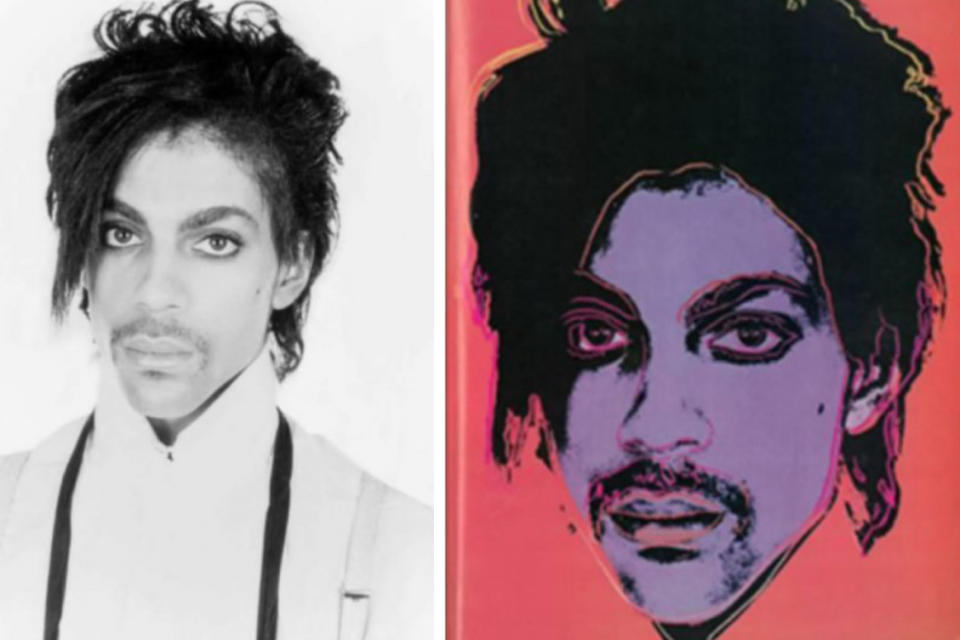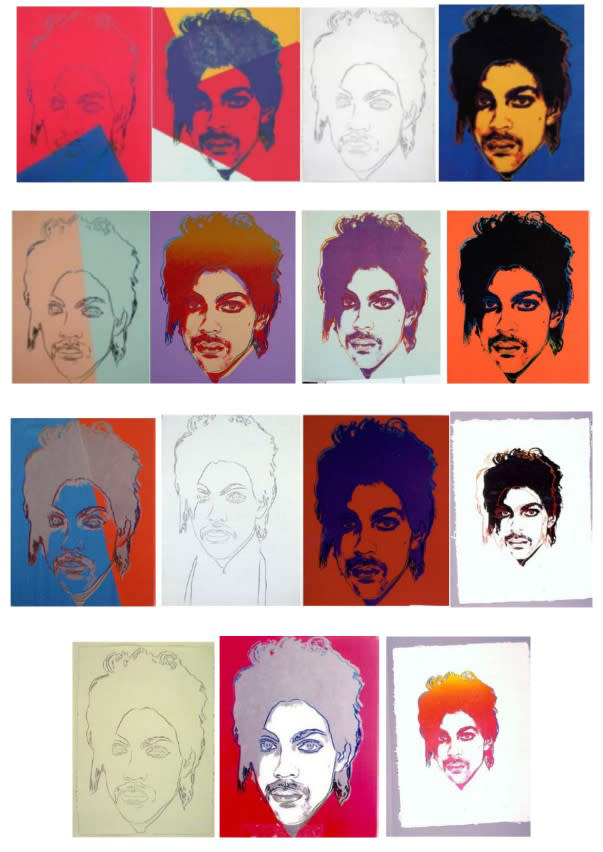Andy Warhol’s portraits of Prince get their 15 minutes of fame in Supreme Court copyright showdown
- Oops!Something went wrong.Please try again later.
- Oops!Something went wrong.Please try again later.
WASHINGTON — Supreme Court justices invoked artists as diverse as Renaissance master Leonardo da Vinci and rap band 2 Live Crew on Wednesday as they probed whether silkscreen prints that pop artist Andy Warhol made of rock star Prince infringed on the copyright of a photographer who captured the original image.
Some justices seemed skeptical that Warhol's images constituted "fair use" under copyright law in part because they did not have a sufficiently different commercial purpose from that of the original photo taken by noted photographer Lynn Goldsmith: Both are used to illustrate magazine articles about Prince.
But other justices seemed concerned that an appeals court had minimized, or even ruled out, any analysis of whether Warhol's work had a significantly different meaning or message from those of Goldsmith's photo. As a result, one option might be to throw out the ruling and require the lower court to try again.

The lively oral argument, in which conservative Justice Clarence Thomas revealed he was once a Prince fan, concerns a legal question of considerable interest to people in all kinds of creative industries, including television, film and fine art. The court wrestled with how to define whether a new work based on an existing one is “transformative" — meaning it does not violate copyright law. Under the law, limited “fair use” of a pre-existing artwork is lawful in certain contexts, including when the new work conveys a different meaning or message.
Goldsmith sued over Warhol’s use of her 1981 photograph of Prince, then a rising star, before he attained global fame on the back of hits like "Little Red Corvette" and "When Doves Cry." As part of an arrangement with Vanity Fair magazine three years later, Warhol created a series of silkscreen prints, as well as two pencil sketches, based on Goldsmith’s image. While the original photo, a portrait of Prince, was black and white, the silkscreen prints superimposed bright colors over a cropped version of the original photo. The style was similar to that of other famous Warhol works, such as his portraits of Marilyn Monroe.
Under a license it had obtained from Goldsmith, Vanity Fair used a Warhol illustration based on the photo in its November 1984 issue without any problems’ arising. But Goldsmith said she was not aware that Warhol had created other images that were not licensed, a fact she became aware of only after Vanity Fair publisher Condé Nast used a different image as part of a 2016 Prince tribute immediately after his death.
Warhol died in 1987, and the relevant works and copyright are held by the Andy Warhol Foundation, which permitted Vanity Fair to use the image in 2016. Goldsmith was not credited.
The next year, the issue ended up in court, with Goldsmith and the foundation suing each other to determine whether Warhol’s image constituted fair use.

In 2019, a federal judge ruled in the foundation’s favor, saying Warhol’s images were transformative because, while Goldsmith’s photo showed a “vulnerable human being,” the Warhol prints depicted an “iconic, larger-than-life figure.”
The foundation sought Supreme Court review after the New York-based 2nd U.S. Circuit Court of Appeals ruled in favor of Goldsmith in March 2021. The appeals court faulted the district court for focusing on the artist’s intent, saying a judge “should not assume the role of art critic.” Instead, a judge must examine whether the new work is of a completely different character from that of the original, the court said. It must, “at a bare minimum, comprise something more than the imposition of another artist’s style on the primary work,” the court added.
During Wednesday's arguments, justices questioned whether Warhol’s image of Prince had a different purpose from Goldsmith’s because both are used in the same way commercially to illustrate articles about the singer. Under copyright law, courts weigh whether a new work will compete with an existing work and undercut its market value.
Justice Sonia Sotomayor questioned the Warhol foundation's lawyer, Roman Martinez, about that issue, asking whether the fact that the images effectively have the same market was enough to “destroy your defense.”
Justice Neil Gorsuch raised a similar point, noting that the Prince images were quite different from Warhol’s famous images of Campbell’s soup cans, because the difference in purpose in the latter instance was obvious.
“Campbell’s soup seems to be an easy case. The purpose of the use for Andy Warhol was not to sell tomato soup in a supermarket. It was to induce a reaction from a viewer in a museum or in other settings,” Gorsuch said.
“The difficulty of this case is that this particular image is being used arguably, maybe, for the same purpose, to identify an individual in a magazine,” he added.
Not all the justices seemed to agree with that assessment, with Chief Justice John Roberts suggesting that Warhol's images and Goldsmith’s photos could be seen as substantively different.
“It’s a different style. It’s a different purpose. One is a commentary on modern society. The other is to show what Prince looks like,” he said.
Justice Elena Kagan seemed to have a similar view, pointing to the fact that Warhol's works are highly sought after by museums because "he was a transformative artist."
Justice Samuel Alito questioned how much courts should defer to expert witnesses when deciding whether a work shows a different meaning. While an average person might view a copy of Leonardo da Vinci’s “Mona Lisa” in which the subject wears a different color of dress, an expert in Renaissance art might see it as transformative, he said.
“You make it sound simple, but maybe it’s not so simple, at least in some cases, to determine what is the meaning or message of a work of art,” Alito told Martinez.
The justices also debated a relevant Supreme Court precedent cited by both sides, a 1994 ruling in which the court held that it was fair use when 2 Live Crew created a song called “Pretty Woman” that was a parody of Roy Orbison’s “Oh, Pretty Woman.” In another pop culture reference, Lisa Blatt, Goldsmith’s lawyer, brought up the value of spinoff works to the entertainment industry, citing TV shows that were based on the 1970s comedy "All in the Family," which itself was based on a British sitcom.
Various interested parties have filed briefs advising the justices about what approach to take, including movie and music industry groups, educational institutions and individual artists. (Universal Pictures, a division of NBC News' parent company, NBCUniversal, is a member of the Motion Picture Association, which filed a brief in support of neither party.)
The parties' approach to the legal question depends in part on to what extent their work relies on protecting their own copyrighted material as opposed to making fair use of other people’s copyrighted content.
This article was originally published on NBCNews.com

